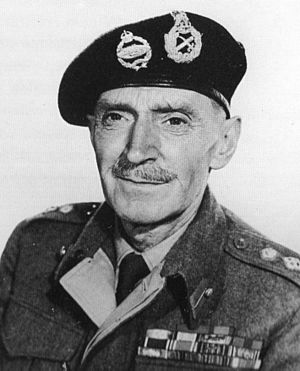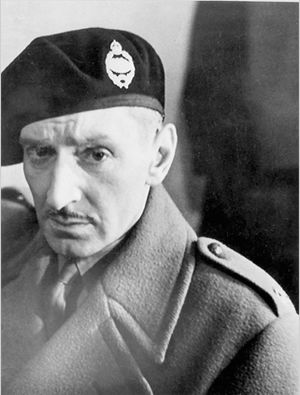M. E. Clifton James facts for kids
Quick facts for kids
Meyrick Edward Clifton James
|
|
|---|---|

Clifton James posing as General Montgomery
|
|
| Born | April 1898 Perth, Australia |
| Died | 5 May 1963 (aged 65) Worthing, England |
| Allegiance | United Kingdom |
| Service/ |
British Army |
| Years of service | 1914–1918 1940–1946 |
| Rank | Lieutenant (WWII) |
| Service number | 141055 (WWII) |
| Unit | Royal Fusiliers (WWI) Royal Army Pay Corps (WWII) |
| Battles/wars |
|
| Other work | Actor |
Meyrick Edward Clifton James was an actor and soldier. He was born in April 1898 and passed away in May 1963. James looked a lot like a famous British general, Field Marshal Bernard Montgomery. The British secret service, MI5, used this amazing similarity during World War II to trick the enemy. This clever plan was part of a big deception campaign.
Contents
Early Life and Acting Career
Clifton James was born in Perth, Western Australia. He was the youngest son of John Charles Horsey James and Rebecca Catherine Clifton.
After fighting in the First World War, James became an actor. He started his acting career with Fred Karno, who also helped Charlie Chaplin become famous.
When World War II began, James wanted to entertain the soldiers. He joined the British Army again. Instead of being an entertainer, he became an officer in the Royal Army Pay Corps. He was promoted to Lieutenant in 1942.
In 1944, people noticed how much he looked like General Montgomery. This led to a very special mission for James.
Operation Copperhead: The Great Deception
In 1944, about seven weeks before D-Day, an officer named Lieutenant-Colonel J. V. B. Jervis-Reid saw James's picture in a newspaper. He immediately noticed James's strong resemblance to General Montgomery. James had briefly appeared as "Monty" in a patriotic show.
MI5, the British intelligence agency, decided to use this similarity. They wanted to confuse German spies. David Niven, a famous actor and army officer, contacted James. He asked James to come to London for a supposed film role.
The secret plan was called Operation Copperhead. Its goal was to make the Germans believe the Allies would invade Southern France first. This would draw German troops away from Normandy, where the real D-Day invasion would happen.
James had to learn how General Montgomery spoke and acted. He joined Montgomery's staff to study him closely. James also had to stop smoking, as Montgomery did not smoke. James had lost a finger in the First World War, so a special fake finger was made for him.
On May 25, 1944, James flew to Gibraltar on Winston Churchill's private plane. At a party there, hints were dropped about a fake invasion plan. German intelligence heard these rumors. James then flew to Algiers. Over the next few days, he made public appearances with General Maitland Wilson. This made the Germans think Montgomery was in the Mediterranean.
James was then secretly flown to Cairo. He stayed there until the real invasion in Normandy began. After about five weeks, he returned to his regular job.
It is hard to know exactly how well this trick worked. Some captured German generals believed it was Montgomery. However, they still suspected it might be a trick.
Life After the War
After the war ended in 1946, James found it hard to get acting jobs. He had to apply for unemployment benefits to support his family.
I Was Monty's Double
In 1954, James wrote a book about his wartime experiences. It was called I Was Monty's Double. This book later became a movie in 1958. The film also starred John Mills and Cecil Parker. James himself played both himself and General Montgomery in the movie!
The movie changed some parts of the story for dramatic effect. For example, "Operation Copperhead" was called "Operation Hambone." The film also added exciting parts like a fake kidnapping attempt.
James also had a small, uncredited role in the 1957 film High Flight. He appeared as Field Marshal Montgomery.
In 1959, James appeared on an American TV show called To Tell the Truth. On the show, a panel of celebrities had to guess which of three people claiming to be "Monty's double" was telling the truth.
Death
Meyrick Edward Clifton James passed away on May 5, 1963. He was 65 years old. He died at his home in Worthing, Sussex, England.
See also
- Political decoy


